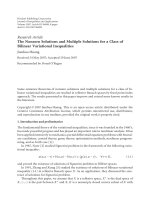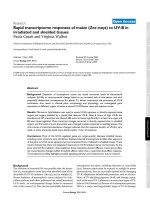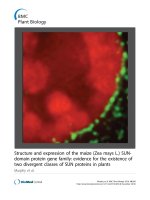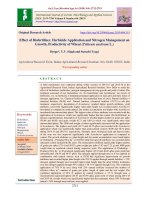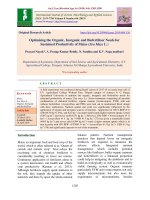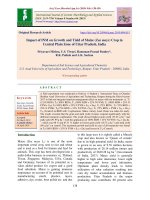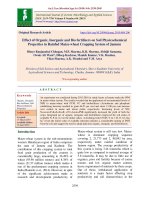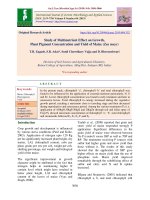Optimising the organic, inorganic and biofertiliser needs for sustained productivity of maize (Zea Mays L.)
Bạn đang xem bản rút gọn của tài liệu. Xem và tải ngay bản đầy đủ của tài liệu tại đây (237.88 KB, 7 trang )
Int.J.Curr.Microbiol.App.Sci (2019) 8(4): 1203-1209
International Journal of Current Microbiology and Applied Sciences
ISSN: 2319-7706 Volume 8 Number 04 (2019)
Journal homepage:
Original Research Article
/>
Optimising the Organic, Inorganic and Biofertiliser Needs for
Sustained Productivity of Maize (Zea Mays L.)
Prayasi Nayak*, A. Pratap Kumar Reddy, N. Sunitha and K.V. Naga madhuri
Department of Agronomy, Department of Soil Science and Agricultural Chemistry, S.V.
Agricultural College, Tirupati, Acharya N.G Ranga Agricultural University, India
*Corresponding author
ABSTRACT
Keywords
Maize
Zea Mays L.,
Organic, Inorganic
and Biofertiliser
Article Info
Accepted:
10 March 2019
Available Online:
10 April 2019
A field experiment was conducted during kharif season of 2017-18 on sandy loam soil of
S.V. Agricultural College Wetland Fam, Tirupati campus of Acharya N. G. Ranga
Agricultural University to optimise the organic, inorganic and biofertiliser needs for
sustained productivity of maize (Zea mays L.). Seven treatments comprising all possible
combinations of chemical fertilizer, organic manure (vermicompost, FYM) with and
without biofertilizer (Azospirillum and PSB) were laid out in randomized block design
with three replications. Nutrient uptake and yield was significantly influenced by the
application of organic and inorganic sources of nutrients. Application of 100 % RDF (T1)
(180-60-50 kg N, P2O5 and K2O ha-1) recorded significantly higher nutrient uptake, kernel
(5207 kg ha-1) and stover yield (6751 kg ha-1). However, 50% RDF + Vermicompost @ 1t
ha-1 + Azospirillum @ 5 kg ha-1+ PSB @ 5 kg ha-1 (T7) has given a remarkable kernel
(4683 kg ha-1) and stover yield (6394 kg ha-1) wand a higher nutrient uptake which is in
turn in parity with 50% RDF + FYM@ 5 t ha-1 + Azospirillum @ 5 kg ha-1+ PSB @ 5 kg
ha-1 (T6) and significantly superior to rest of the treatments.
Introduction
Maize an important food and feed crop of the
world, which is often referred to as ‘Queen of
cereals and miracle crop’. Now-a-days the
escalating cost of chemical fertilizers is
considerably resulting in lower net returns.
Continuous application of fertilizers alone in
a system deteriorates soil health and affects
crop productivity (Kannan et al., 2013).
Although fertilizers supply quick nutrients to
the soil, they impede the uptake of other
nutrients and there by upset the whole mineral
balance pattern. Nutrient management
practices that depend lesser on inorganic
fertilizers are required to minimize the
adverse
effects.
Integrated
nutrient
management, which includes potential
sources like fertilizers, bulky organic manures
and biofertilisers in a balanced proportion
could help in mitigating the problems and to
build an ecologically as well as economically
viable farming system. Organic manures
particularly FYM and vermicompost, not only
supply macronutrients but also meet the
requirement of micronutrients, besides
1203
Int.J.Curr.Microbiol.App.Sci (2019) 8(4): 1203-1209
improving soil health (Wailare and
Kesarwani, 2017). Biofertilisers are the low
cost inputs for supplementing the essential
plant nutrients to achieve sustainable
agriculture. The presence of different
microbes, enzymes and hormones enhance the
availability of soil inherent nutrients by the
formation of organic acids. Hence, massive
efforts are to be adopted with integration of
organic, inorganic and biological sources of
plant nutrients in the developing countries for
improvement of soil fertility and productivity
(Hashim et al., 2016).
Materials and Methods
The field experiment was conducted at S.V.
Agricultural College Wetland Farm, Tirupati
campus of Acharya N. G. Ranga Agricultural
University in kharif, 2017. Total rainfall
received during the crop growth period was
833.6 mm in 42 rainy days. The soil of the
experimental field was sandy loam in texture,
slightly alkaline in soil reaction (pH 7.9), low
in organic carbon (0.25 %) and available N
(125 kg ha-1) and medium in available
phosphorus (11.7 kg ha-1) and available
potassium (223.3 kg ha-1).
The field experiment was laid out in
Randomized Block Design (RBD). There
were seven treatments and three replications.
The treatment details are furnished below
T1: 100% recommended dose of fertiliser
(RDF =180-60-50 kg N, P2O5 and K2O ha-1)
T2: FYM @ 10 t ha-1 + Azospirillum @ 5
kgha-1 + PSB @ 5 kg ha-1
T3: Vermicompost @ 2 t ha-1 + Azospirillum
@ 5 kgha-1 + PSB @ 5 kg ha-1
T4: 50% RDF + FYM @ 5 t ha-1
T5: 50% RDF + Vermicompost @ 1 t ha-1
T6: 50% RDF + FYM @ 5 t ha-1 +
Azospirillum @ 5 kg ha-1 + PSB @ 5 kg ha1
T7: 50% RDF + Vermicompost @ 1 t ha-1 +
Azospirillum @ 5 kg ha-1 + PSB @ 5 kg ha-1
Farm yard manure and Vermicompost were
incorporated in marked plots as per treatments
and its composition on dry basis was 0.51 %
N, 0.25 % P2O5, 0.52 % K2O for FYM and
1.7 % N, 1.1 % P2O5, 1.0 % K2O. Full dose of
phosphorus (60 kg ha-1) and potassium (50 kg
ha-1) in the form of single super phosphate
(SSP) and muriate of potash (MOP) were
applied as basal dose at the time of sowing.
Nitrogen (180 kg ha-1) in the form of urea was
applied as per the treatments in three splits
viz., 1/3rd as basal, 1/3rd at knee high stage and
the remaining 1/3rd at tasseling stage through
band placement. The crop was harvested on
28 october in 2017.
Results and Discussion
Nutrient uptake
Different treatments significantly (P<0.05)
influenced nutrient uptake in maize (Table 1).
The maximum nitrogen uptake (139 kg ha-1)
by plant at harvest was recorded with
application of 100% RDF (T1), which was
significantly superior over rest of the nutrient
management practices tried. Recommended
levels of nutrient application enhance the
nutrient availability at the rhizosphere of the
crop, which inturn enables the greater
absorption of nutrients. Application of
biofertiliser increased the nitrogen uptake by
21 per cent with supply of 50% RDF +
Vermicompost @ 1 t ha-1 + Azospirillum @ 5
kg ha-1 + PSB @ 5 kg ha-1 (T7) over 50%
RDF + Vermicompost @ 1 t ha-1 (T5) and by
20 per cent with 50% RDF + FYM @ 5 t ha-1
+ Azospirillum @ 5 kg ha-1 + PSB @ 5 kg ha1
(T6) over 50% RDF + FYM @ 5 t ha-1 (T4).
It might be due to promoting effect of
1204
Int.J.Curr.Microbiol.App.Sci (2019) 8(4): 1203-1209
Azospirillum and their ability to produce
biologically active substances, provision of
significant amount of available nitrogen
through biological nitrogen fixation, improve
photosynthesis and promoting root growth
which in turn enhances nutrient uptake.
The maximum phosphorus uptake was
recorded with application of 100% RDF (T1),
which was significantly superior over rest of
the treatments tried (Table 1 and Fig. 1). The
lower phosphorus uptake was observed with
sole application of organic sources through
FYM @ 10 t ha-1 + Azospirillum @ 5 kg ha-1
+ PSB @ 5 kg ha-1 (T2) which was on par
with Vermicompost @ 2 t ha-1 + Azospirillum
@ 5 kg ha-1 + PSB @ 5 kg ha-1 (T3). Presence
of phosphorus solubilising bacteria in T7
(50% RDF + Vermicompost @ 1 t ha-1 +
Azospirillum @ 5 kg ha-1 + PSB @ 5 kg ha-1)
and T6 (50% RDF + FYM @ 5 t ha-1 +
Azospirillum @ 5 kg ha-1 + PSB @
5 kg ha-1) resulted in more phosphorus
uptake. It might be due to the phosphatic
biofertilisers, in the form of micro organisms
could have helped in increasing the
availability of accumulated phosphates for
plant growth by solubilization which inturn
enhanced the availability of plant growth
substances. These findings are in agreement
with Hameeda et al., (2008). The potassium
uptake by plant was significantly increased
due to the application of entire dose of
recommended NPK through fertilizers (T1)
which was significantly superior to all other
treatments. Next higher uptake recorded with
50% RDF + Vermicompost @ 1 t ha-1 +
Azospirillum @ 5 kg ha-1 + PSB @ 5 kg ha-1
(T7) which was however comparable with
50% RDF + FYM @ 5 t ha-1 + Azospirillum
@ 5 kg ha-1 + PSB @ 5 kg ha-1 (T6). Critical
observations of the data revealed that
potassium uptake by the crop was increased
with increase in level of nitrogen (Table 1 and
Fig. 1), which might be due to the enhanced
number of small root hairs which in turn
facilitated the absorbing ability per unit dry
weight (Sunitha and Reddy, 2012).
Yield
Adequate nutrient management in maize
either with inorganic sources or their
combined use significantly enhanced kernel
and stover yield. Application of 100 % NPK
through inorganic sources of fertilizer
significantly improved the maize yield (T1).
The maximum kernel yield (5207 kg ha-1) was
obtained with T1 with the application of entire
dose of recommended NPK through fertilizers
and it was significantly superior to 100%
organic and integrated nutrient management
practices (Table 2). The second best treatment
was T7 (50 % RDF + Vermicompost @ 1t ha-1
+ Azospirillum @ 5 kg ha-1 + PSB @ 5 kg ha1
) which was on par with T6 (50% RDF +
FYM@ 5 t ha-1 + Azospirillum @ 5 kg ha-1 +
PSB @ 5 kg ha-1) also recorded higher kernel
and stover yield over rest of the treatments.
Integrating Azospirillum and PSB along with
FYM, Vermicompost and RDF produced
remarkable yield compared to sole application
of organics. Organic manures like FYM and
vermicompost also supply nutrients beneficial
to crop growth and productivity. Therefore,
substitution of 50% inorganic fertilizers with
Vermicompost / FYM in combination with
bio fertilizer had given the kernel yield which
was comparable to 100 % RDF. This is in
confirmation with the findings of Shah and
Wani (2017).
Integration of biofertilizer in treatment T7 (50
% RDF + vermicompost @ 1t ha-1 +
Azospirillum @ 5 kg ha-1 + PSB @ 5 kg ha-1)
and T6 (50% RDF + FYM@ 5 t ha-1 +
Azospirillum @ 5 kg ha-1 + PSB @ 5 kg ha-1)
recorded 19 and 23 per cent more yield
compared to T4 (50% RDF + FYM@ 5 t ha-1)
and T5 (50 % RDF + Vermicompost @ 1t
ha-1) which did not include biofertilizer (Fig.
2).
1205
Int.J.Curr.Microbiol.App.Sci (2019) 8(4): 1203-1209
Table.1 Nutrient (N, P and K) uptake (kg ha-1) by maize as influenced by various nutrient
management practices
Treatments
T1 : 100% RDF (180-60-50 kg N, P2O5 and
K2O ha-1)
T2 : FYM @ 10 t ha-1 + Azospirillum @ 5 kg
ha-1 + PSB @ 5 kg ha-1
T3 : Vermicompost @ 2 t ha-1 + Azospirillum
@ 5 kg ha-1 + PSB @ 5 kg ha-1
T4 : 50% RDF + FYM @ 5 t ha-1
T5 : 50% RDF + Vermicompost @ 1 t ha-1
T6 : 50% RDF + FYM @ 5 t ha-1 +
Azospirillum @ 5 kg ha-1 + PSB @ 5 kg
ha-1
T7 : 50% RDF + Vermicompost @ 1 t ha-1 +
Azospirillum @ 5 kg ha-1 +
PSB @ 5 kg ha-1
SEm±
CD (P=0.05)
N uptake
139
P uptake
37.7
K uptake
128
76.2
18.0
73.0
78.3
19.6
75.7
92.1
96.8
115
23.9
25.7
30.5
88.8
93.2
104
123
32.8
112
2.9
9.1
0.9
2.8
2.9
8.9
Table.2 Kernel yield, stover yield (kg ha-1) and harvest index of maize as influenced by various
nutrient management practices
Treatments
Kernel
yield
(kg ha-1)
5207
T1 : 100% RDF (180-60-50 kg N, P2O5 and K2O ha-1)
-1
-1
T2 : FYM @ 10 t ha + Azospirillum @ 5 kg ha + PSB 2059
@ 5 kg ha-1
T3 : Vermicompost @ 2 t ha-1 + Azospirillum @ 5 kg 2352
ha-1 + PSB @ 5 kg ha-1
3660
T4 : 50% RDF + FYM @ 5 t ha-1
-1
3949
T5 : 50% RDF + Vermicompost @ 1 t ha
-1
T6 : 50% RDF + FYM @ 5 t ha + Azospirillum @ 5 kg 4534
ha-1 + PSB @ 5 kg ha-1
4683
T7 : 50% RDF + Vermicompost @ 1 t ha-1 +
-1
Azospirillum @ 5 kg ha +
PSB @ 5 kg ha-1
88
SEm±
271
CD (P=0.05)
1206
Stover
yield
(kg ha-1)
6751
4937
Harvest
index
(%)
43.5
29.4
4950
32.2
5790
5815
6206
38.7
40.5
42.2
6394
42.2
114
317
0.61
1.87
Int.J.Curr.Microbiol.App.Sci (2019) 8(4): 1203-1209
Fig.1 Nutrient uptake (kg ha-1) by maize as influenced by various nutrient management practices
Fig.2 Kernel yield and stover yield (kg ha-1) of maize as influenced by various nutrient
management practices
These results are in accordance with the
findings of Beigzade et al., (2013) Hashim et
al.(2015). and Rasool et al., (2015).
Similar to kernel yield, stover yield was also
significantly influenced by different organic
and inorganic nutrient management practices.
Among all the nutrient management practices,
1207
Int.J.Curr.Microbiol.App.Sci (2019) 8(4): 1203-1209
higher stover yield of maize (6751 kg ha-1)
was recorded with 100% RDF (T1), which
was significantly superior over rest of the
nutrient management practices tried. Next
best treatment was 50% RDF +
Vermicompost @ 1 t ha-1 + Azospirillum @ 5
kg ha-1 + PSB @ 5 kg ha-1 (T7) which was in
parity with 50% RDF + FYM @ 5 t ha-1 +
Azospirillum @ 5 kg ha-1 + PSB @ 5 kg ha-1
(T6).s
Stover yield of maize was the combined effect
of plant height and dry matter accumulation
and both the parameters were found to be
higher with the higher level of NPK supplied
through 100% RDF (T1). This might be due to
increased availability of essential plant
nutrients from the balanced supply of
nutrients. Enhanced stover yield is the
outcome of the positive and synergistic
interaction between the nutrient supply and
growth stature of maize as reflected in
enhanced growth parameters with supply of
the higher optimum dose of NPK with
integration of organics and biofertilisers.
Similar result was noticed by Tetarwal et al.,
(2011).
2 t ha-1 + Azospirillum @ 5kg ha-1 + PSB@ 5
kg ha-1) due to poor vegetative growth caused
by sub optimum supply of nutrients.
In conclusion, the present study revealed that
higher productivity of maize as well as
economic returns could be realized with
100% recommended dose of nutrients through
fertilizers i.e. 180-60-50 kg N, P2O5 and K2O
ha-1. Among the various integrated nutrient
management practices, application of 50%
RDF + Vermicompost @ 1 t ha-1 +
Azospirillum @ 5 kg ha-1 + PSB @ 5 kg ha-1
proved to be the most promising and feasible
approach for higher yield where as 50% RDF
+ FYM @ 5 t ha-1 + Azospirillum @ 5 kg ha-1
+ PSB @ 5 kg ha-1 (T6) was economically
viable, along with maintenance of soil
biological activity and fertility for the
sustenance of soil ecology. Hence, adoption
of a balanced nutrient management approach
will safeguard the desire for higher crop
productivity with economic returns. Long run
adoption of combined use of fertilizers and
organics expected to match and even excel the
sole fertilizer based production strategy.
References
The increase in kernel and stover yield with
50% RDF + Vermicompost @ 1 t ha-1 +
Azospirillum @ 5 kg ha-1 + PSB @ 5 kg ha-1
(T7) followed by 50% RDF + FYM @ 5 t ha-1
+ Azospirillum @ 5 kg ha-1 + PSB @ 5 kg ha1
(T7) might be due to sufficient amount of the
released nutrients by mineralization at a
constant level and increased the nutrient
uptake under better soil environment that had
been created owing to cumulative effect of
organic sources combined with inorganic
source of nutrients, which in turn improved
plant growth and subsequently the kernel and
stover yield as reported by Hashim et al.,
(2015). The lower stover yield (4937 kg ha-1)
was recorded with T2 (FYM @ 10 t ha-1 +
Azospirillum @ 5 kg ha-1 + PSB @ 5 kg ha-1)
which was on par with T3 (Vermicompost @
Beigzade, M., Maleki, A., Siaddat, S.A and
Mohammadi, M.M. 2013. Effect of
combined application of phosphate
fertilizers and phosphate solubilising
bacteria on
yield
and
yield
components of maize single cross 704.
International Journal of Agriculture
and Crop Sciences 6(17): 1179-1185.
Hameeda, B., Harini, G., Rupela. O.P., Wani,
S.P and Reddy, G. 2008. Growth
promotion of maize by phosphatesolubilizing bacteria isolated from
compost
and
macrofauna.
Microbiological Research. 163: 234242.
Hashim, A.F., Hatim, A.A.A and Soumya,
S.M. 2016. Effects of chemical and
1208
Int.J.Curr.Microbiol.App.Sci (2019) 8(4): 1203-1209
bio-fertilizers
on
yield,
yield
components and grain quality of maize
(Zea mays L.). African Journal of
Agricultural Research. 11(45): 46544660.
Hashim, M., Dhar, S., Vyas, A.K., Pramesh,
V and Kumar, B. 2015. Integrated
nutrient management in maize (Zea
mays) – wheat (Triticum aestivum)
cropping system. Indian journal of
Agronomy. 60(3): 352-359.
Kannan, L.R., Dhivya, M., Abinaya, D.,
Krishna, R.L and Krishnakumar, S.
2013. Effect of integrated nutrient
management on soil fertility and
productivity in Maize. Bulletin of
Environment, Pharmacology and Life
Sciences. 2(8): 61-67.
Rasool, S., Kanth, R.H., Hamid, S., Raja, W.,
Alie, B.A and Dar, Z.A. 2015.
Influence of Integrated nutrient
management on growth and yield of
sweet corn (Zea mays L. saccharata)
under temperate conditions of
Kashmir Valley. American Journal of
Experimental Agriculture. 7(5): 315325.
Shah, R.A and Wani, B.A. 2017. Yield,
nutrient uptake and soil fertility of
maize (Zea mays L.) as influenced by
varying nutrient management practices
under temperate conditions of
Kashmir valley, India. Plant Archives.
17(1): 75-78
Sunitha, N and Reddy, P.M. 2012. Effect of
graded nutrient levels and timing of
nitrogen application on yield and
quality of sweet corn. Madras
Agricultural Journal. 99(4-6): 240243.
Tetarwal, J.P., Ram, B and Meena, D.S 2011.
Effect
of
integrated
nutrient
management
on
productivity,
profitability, nutrient uptake and soil
fertility in rainfed maize (Zea mays).
Indian Journal of Agronomy. 56(4):
373-376.
Wailare, A.T and Kesarwani. A. 2017. Effect
of integrated nutrient management on
growth and yield parameters of maize
(Zea mays L.) As well as soil physicochemical
properties.
Biomedical
Journal of Scientific and Technical
Research.
How to cite this article:
Prayasi Nayak, A. Pratap Kumar Reddy, N. Sunitha and Naga madhuri, K.V. 2019. Optimising
the Organic, Inorganic and Biofertiliser Needs for Sustained Productivity of Maize (Zea Mays
L.). Int.J.Curr.Microbiol.App.Sci. 8(04): 1203-1209.
doi: />
1209

